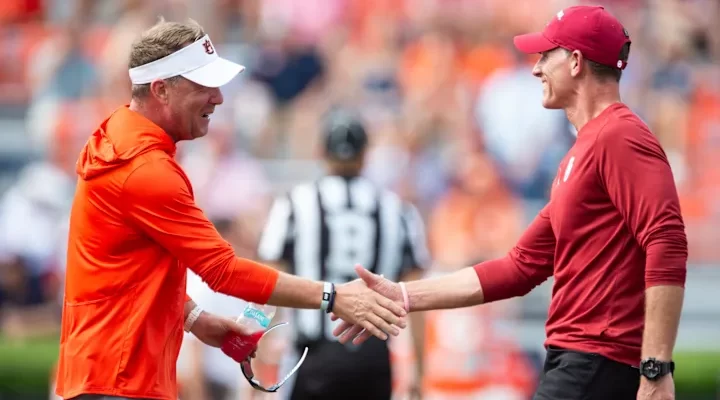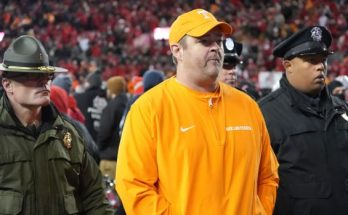How Alabama Football vs. Auburn Recruiting Narrative Has Flipped in the 2026 Class
When it comes to college football in the state of Alabama, there has always been a fierce rivalry between the University of Alabama and Auburn University. Historically, Alabama has long been the dominant force in recruiting, with their unmatched success on the field driving a wave of top-tier prospects to Tuscaloosa year after year. Auburn, on the other hand, has often played the underdog role, striving to catch up to the Crimson Tide’s recruiting juggernaut.
But in 2026, something remarkable is happening: the recruiting narrative in the state of Alabama is flipping. Auburn is suddenly outpacing Alabama in securing top talent, and this shift is making waves across the college football world.
For years, Alabama football has been synonymous with excellence. Under head coach Nick Saban, the Crimson Tide has built an empire of recruiting dominance, producing countless NFL draft picks and championship-caliber teams. The allure of playing for Saban, the culture of winning, and the prestige of Alabama football has made it a coveted destination for the best high school athletes in the country.
Meanwhile, Auburn, despite having its share of success, particularly with its own championship run in 2010, has often found itself fighting for scraps when it comes to the state’s top recruits. With a relatively smaller football program, fewer national championships, and a reputation for inconsistency, Auburn has struggled to keep pace with Alabama in recruiting.
But now, the tide appears to be shifting. Auburn, led by head coach Hugh Freeze, is out-recruiting Alabama in the 2026 class, and the implications for the state’s football landscape are profound.
The most significant catalyst behind Auburn’s recruiting surge is Hugh Freeze, who took over as head coach in 2023. Known for his offensive-minded approach and success at previous stops like Ole Miss and Liberty, Freeze quickly made it clear that he was committed to building a winning program at Auburn. His ability to connect with recruits and convince them to commit to his vision for the program has played a massive role in Auburn’s rise.
Freeze’s offensive philosophy is attractive to high school prospects, particularly on the offensive side of the ball. His reputation for developing quarterbacks has proven to be a major selling point for recruits looking to showcase their talents on the national stage. As the 2026 class began to take shape, Auburn quickly became a more prominent player in the recruiting wars, securing commitments from top-ranked players that in previous years would have been Alabama-bound.
One of the key elements of Freeze’s strategy has been his ability to leverage Auburn’s unique identity. While Alabama is known for its dynasty status and polished, professional approach, Auburn markets itself as a place for underdogs to thrive—where players can come to a program that is hungry, passionate, and ready to prove itself on the national stage. This has resonated with a new generation of recruits looking for more than just championships—they want an opportunity to make a difference, to be part of something that can flip the script.
In 2026, Auburn’s recruiting efforts have been nothing short of impressive. The Tigers have landed commitments from several of the state’s top prospects, including a pair of five-star recruits who were once considered solid Alabama locks. These players, who would have been seen as automatic Crimson Tide signees just a few years ago, have now committed to Auburn, sending shockwaves through the recruiting world.
One key factor in Auburn’s ability to win these recruiting battles is the relationship Freeze has built with high school coaches across the state. Alabama’s recruiting strategy has long been to cherry-pick the best players from Alabama and beyond, but Auburn is now making a concerted effort to develop local relationships, ensuring that the Tigers are in the conversation for top recruits every year. As a result, several high-profile recruits have opted for Auburn, sensing an opportunity to stay close to home while playing for a coach who believes in their potential.
So, what’s behind Alabama’s relative struggles in the 2026 class? There’s no single reason for the dip in recruiting success, but several factors have played a role in this shift.
-
The End of an Era: Nick Saban is a living legend, but the reality is that his tenure at Alabama is coming to an end. While there’s no set timetable for Saban’s retirement, the uncertainty surrounding the future of the program is a concern for recruits. With Saban’s legendary status slowly winding down, recruits are looking to programs where they can build their legacies—not simply join an established dynasty.
-
The Rise of Competition: Auburn isn’t the only program that’s been gaining ground in Alabama’s recruiting territory. Other SEC rivals like Georgia, LSU, and Tennessee have been investing heavily in their recruiting efforts, making it harder for Alabama to maintain the same level of dominance. Alabama is no longer the only “big dog” in the SEC when it comes to recruiting, and that’s forcing the Crimson Tide to compete more fiercely for in-state talent.
-
The Transfer Portal: The rise of the transfer portal has also complicated things for Alabama. With more players opting to transfer instead of sticking around to develop under Saban’s system, it’s made it harder for Alabama to maintain the depth it once had. While the portal can be a powerful tool for filling gaps, it has also created a shift in how teams are building their rosters, making it more difficult for programs like Alabama to rely on traditional recruiting tactics alone.
-
The Pressure to Win: Alabama’s recruiting machine has always been fueled by the team’s ability to win championships, but the Crimson Tide has had a more challenging time winning titles in recent years. While still a top-tier program, Alabama has been unable to capture a national championship since 2020. With teams like Georgia and LSU rising to prominence, recruits are no longer looking solely at Alabama as the guaranteed path to a national title. They are looking for programs with upward momentum—and Auburn’s recent surge fits that description.
The shift in recruiting power from Alabama to Auburn in the 2026 class is more than just a one-year blip—it could signal a long-term change in the landscape of college football in Alabama. Auburn’s rise presents a challenge to the established order, and it could lead to an overall more competitive SEC. If Freeze is able to continue building on his early success at Auburn, the Tigers could become a perennial recruiting powerhouse, forcing Alabama to up its game in ways that could make the entire conference stronger.
For recruits, this new dynamic offers more opportunities than ever before. They can choose between two powerhouse programs in the same state, each offering different paths to success. For Alabama, this presents a challenge, as the days of easily securing in-state recruits are now behind them. It’s a reminder that even the most dominant programs can’t rest on their laurels.
As the 2026 recruiting class continues to take shape, all eyes are on both Alabama and Auburn. Will Alabama regain its recruiting dominance, or is Auburn’s rise part of a new era for the Tigers? Can Hugh Freeze sustain his momentum and turn Auburn into a true contender for national championships in the near future?
One thing is certain: college football in Alabama will never be the same. Whether you’re a Crimson Tide fan or an Auburn supporter, the competition between these two programs will be more intense than ever before. The narrative has shifted, and it’s going to be fascinating to see how the rest of the recruiting cycle plays out.
In the end, college football is about more than just the games played on the field—it’s about the stories of players, coaches, and programs that shape the sport. In 2026, the Alabama-Auburn rivalry has a new chapter, and it’s one that could change the course of college football in the state for years to come.



